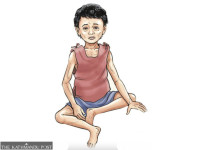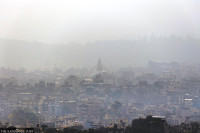Health
Hospitals are fuelling superbugs in Nepal, study finds
Antimicrobial-resistance genes may have found their way into rivers, soil, farms, communities, report says.
Arjun Poudel
Healthcare facilities, especially major hospitals in Nepal, could be the major reservoirs and amplifiers of antimicrobial resistance, as a new finding shows widespread antibiotics-resistance genes within hospital wastewater infrastructures.
The report titled, “Antibiotic Resistance Gene Surveillance in Hospital Wastewater in Nepal”, prepared by BioVac Nepal and Resistomap, a Finland-based research institution that maps antibiotic resistance across the globe, showed the presence of multiple antibiotic-resistance genes in the wastewater.
The study assessed the burden and diversity of antibiotic-resistance genes in sewage water from two major Kathmandu Valley hospitals—Patan Hospital and Nepal-Korea Friendship Hospital.
DNA was extracted at BioVac Nepal and antimicrobial resistance genes (ARG) screening was carried out using a 72-gene smart ChipqPC panel at Resistomap, Helsinki, targeting resistance markers, targeting key antibiotics classes—β-lactamases, carbapenem-resistance genes, and tet (tetracycline), sulfonamides, aminoglycosides and others.
“Relative abundance profiles consistently detected high concentrations of major resistance gene classes—β-lactamases, carbapenem-resistance genes, tetracycline families, MLSB, and sulfonamide resistance genes,” reads the report.
“The detection of these five antimicrobial-resistance gene categories in raw hospital wastewater indicates that healthcare facilities act as major reservoirs and amplifiers of antimicrobial resistance, with the potential to spread resistant organisms into river systems, soil, agriculture, and human communities.”
The study was carried out in 2023 over a six-month period. Samples were collected twice per day—morning and evening—for three consecutive days from three buildings at Patan Hospital: the medical and surgical wards, outpatient clinics, and the maternity and obstetric and gynecology ward.
“A high diversity of antimicrobial-resistance genes was consistently detected across all wards and all sampling times,” the report stated. “ The presence of multiple resistance classes across all buildings indicates widespread antimicrobial resistance circulation within hospital wastewater infrastructure.”
Likewise, samples were collected once a week for 12 weeks at Nepal-Korea Friendship Hospital which also showed stable and persistent detection of a broad panel of antimicrobial resistance genes throughout the 12-week period. Similar to Patan Hospital, dominant antimicrobial-resistance gene categories included β-lactam, tetracycline, MLSB, and sulfonamide resistance genes.
“Both hospitals demonstrate significant and sustained ARG loads, highlighting untreated hospital wastewater as an important reservoir for antimicrobial resistance,” reads the report.
Hospital waste management is an important, but neglected issue in Kathmandu. Officials said that private health facilities—hospitals, nursing homes, polyclinics, laboratories— and even state-run health facilities discard hazardous medical waste mixing up with household waste.
Moreover, none of the hospitals in the country has facilities for treating waste water, which increases the risk of spread of antimicrobial-resistance genes and other infections in the communities, according to experts.
“Due to a lack of wastewater treatment facilities in our health institutions, contaminated water flows directly into major rivers and this increases the risk of spreading antimicrobial-resistance genes,” said Dr Dibesh Karmacharya, executive director of Center for Molecular Dynamics Nepal, a non-governmental public health research organisation. “Risk of antimicrobial resistance increases if such water is used for drinking and in agriculture.”
Antimicrobial resistance has been emerging as a serious public health issue or a ‘silent pandemic’ in Nepal, public health experts say. The problem has reached an alarming level which most people in the country cannot imagine, they warn.
Doctors and public health experts in Nepal have long drawn the attention to the irrational use of antibiotics. They say that despite their efforts to raise awareness, rampant use of antibiotics continues.
According to experts, agricultural antibiotics contribute to resistant bacteria in meat and poultry products. In addition, resistant organisms are released from farms into soil, groundwater, and surface waterways, contaminating water sources used for crop irrigation and domestic purposes.
The World Health Organisation said antimicrobial resistance occurs when bacteria, viruses, fungi and parasites change over time and no longer respond to medicines, making infections harder to treat and increasing the risk of disease spread, severe illness and death. As a result, the medicines become ineffective and infections persist in the body, increasing the risk of their spread to others.




 7.12°C Kathmandu
7.12°C Kathmandu














